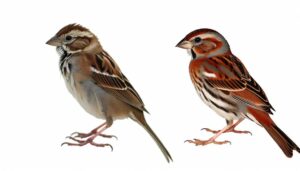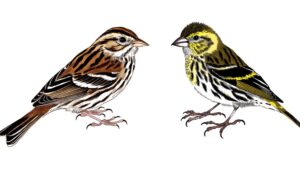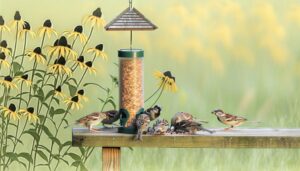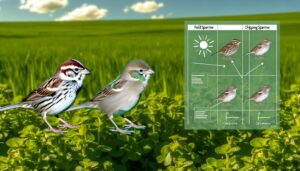5 Essential Steps for Abandoned Baby Tree Sparrow Care
To care for an abandoned baby tree sparrow, one must first provide a warm, dry shelter using a soft-lined box. Next, the bird requires a strict feeding regimen involving a mixture of puppy or kitten milk replacer every 15-20 minutes during the day.
The bird's health must be closely monitored for signs such as dehydration or lethargy. Any signs of distress should warrant immediate attention from a wildlife rehabilitator.
Finally, we must remember that these steps are introductory, a starting point. Further insights into sparrow behavior, ensuring a healthy environment, and preparing the sparrows for release can enhance their survival chances.
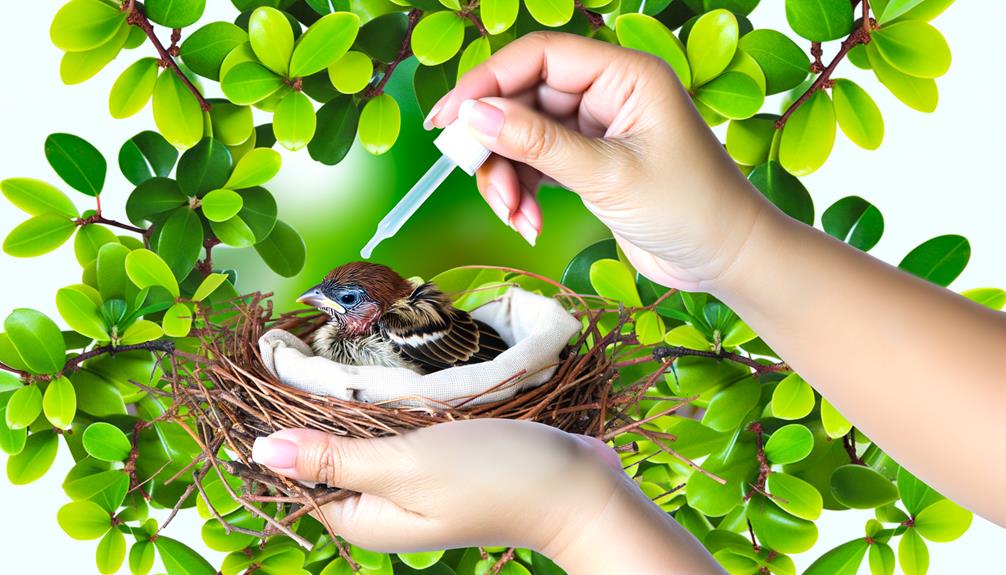
Key Takeaways
- Identify abandoned baby tree sparrows by their small size, sparse feathers, and inability to fly.
- Provide shelter in a warm, quiet area using a small box lined with soft tissues.
- Feed the baby sparrow every 15-20 minutes during the day using puppy or kitten milk replacer.
- Regularly monitor the sparrow's health for signs of dehydration, lethargy, and digestion issues.
- Seek professional help from a local wildlife rehabilitator or a veterinarian if signs of illness are present.
Identifying a Tree Sparrow
In the midst of nature's vast array, recognizing a Tree Sparrow involves careful observation of its distinctive features such as its chestnut-brown crown and nape, black patches on its pure white cheeks, and a small black bib under its beak.
This species, scientifically known as Passer montanus, is smaller than a House Sparrow, averaging about 14 cm in length. It has a stout body, short tail, and powerful beak, all common traits in sparrows.
The Tree Sparrow's wings display a unique pattern, having two white wing bars that contrast against the otherwise brown plumage. It's the male and female's similar appearance that often confuses observers.
Through a meticulous differentiation process, one can accurately identify this bird, imperative for its proper care and conservation.
Understanding Sparrow Behavior
While it may seem as though sparrows simply flutter about aimlessly, they actually exhibit a complex array of behaviors that reflect their adaptability and resilience. For instance, their social nature is evident in their flocking behavior, often seen in large communal roosts.
Sparrows are also known for their vocal communication, using a variety of chirps and calls to signal danger, locate mates, or establish territory. Their feeding habits are versatile, ranging from seeds, to insects, to scraps, showcasing their opportunistic survival strategy.
Moreover, their flight patterns, characterized by rapid wing beats and brief glides, are indicative of their agile nature. Understanding these behaviors aids in the effective care of abandoned baby sparrows, enabling one to cater to their needs more proficiently.
Initial Baby Sparrow Assessment
Upon discovering an abandoned baby sparrow, it's crucial to conduct an initial assessment, meticulously noting the bird's physical condition and observable behaviors to determine its overall health and immediate needs.
Observers should inspect the bird's plumage for any abnormalities, such as mites or lice, as these could indicate underlying health issues. The bird's weight and size should also be assessed; underweight birds may need immediate nutritional support. Check for physical injuries, like wounds or deformities as well.
Observing the bird's behavior is also important. An alert and active baby sparrow is generally healthier than one appearing lethargic or disoriented. In conclusion, note if it's breathing normally or showing signs of respiratory distress. This detailed analysis will guide the next steps in care.
Preparing a Temporary Nest
The construction of a temporary nest for the abandoned baby tree sparrow requires careful selection and assembly of suitable materials. Each element contributes to the nest's ability to mimic the natural environment, providing the necessary comfort and safety for the fledgling.
The detailed process involves a keen understanding of the sparrow's biological needs, and the scientific knowledge to replicate these conditions artificially.
Gathering Suitable Materials
First and foremost, one must gather necessary materials such as a small box, clean rags or soft cloths, a heating pad or warm water bottle, and a dropper or small syringe for food and water provision to prepare an impromptu nest for the abandoned baby tree sparrow.
The box serves as a safe, enclosed space mimicking the bird's natural nesting environment. Clean rags or soft cloths mimic the comfort of the mother's feathers, providing warmth and security. The heating pad or warm water bottle is essential to maintain the bird's body temperature, as baby sparrows can't regulate their own. The dropper or syringe, finally, is used for precise delivery of liquid nourishment, crucial for the bird's survival.
Each item serves a specific function, contributing to a makeshift habitat that closely replicates a sparrow's natural nest.
Assembling the Nest
Once you've gathered all the necessary materials, you'll need to carefully assemble the temporary nest, paying close attention to detail to make sure it closely mimics the ideal conditions for a baby tree sparrow.
Follow these three steps:
- Shape the nest: Use your hands to mold the base material into a shallow, cup-like shape. This will create a safe, comfortable space for the baby sparrow.
- Line the nest: Line the bottom of the nest with soft materials, like feathers or fabric, to provide insulation and comfort.
- Position the nest: Place the nest in a warm, quiet area, away from direct sunlight and potential predators.
Ideal Conditions for Housing
Creating a suitable living environment for an abandoned baby tree sparrow isn't a task to be taken lightly; it requires careful consideration of temperature, space, and safety measures to mimic their natural habitat as closely as possible.
Ideally, housing for these delicate creatures must maintain a consistent temperature of around 24-28 degrees Celsius. This simulates the warmth they'd receive nestled under their mother's wings.
The enclosure should also provide ample space for the bird to move, yet compact enough to give a sense of security. Safety measures are imperative. The housing should be predator-proof and well ventilated to prevent overheating.
Soft, non-abrasive materials should line the bottom to protect the sparrow's tender skin, thereby creating an environment conducive to their survival and growth.
Procuring Appropriate Feed
While ensuring a comfortable habitat is crucial, procuring the right feed for an abandoned baby tree sparrow is equally important in supporting its growth and development.
- Hand-rearing Mix: This is a commercially available product designed specifically for feeding fledgling birds. It contains essential nutrients and proteins that support healthy growth.
- Insects: Baby tree sparrows are primarily insectivores. Their feed should include mealworms, crickets, or other small insects. These provide necessary proteins and can be bought from pet stores.
- Berries and Seeds: As the sparrow grows, its diet should gradually include berries and seeds. These are a natural part of an adult sparrow's diet and help shift the bird from a juvenile to an adult dietary regime.
Feeding Techniques and Schedule
Exploring the intricacies of feeding abandoned baby tree sparrows entails a thorough understanding of their dietary requirements and a strict adherence to a feeding timetable.
The next section delves into the vital elements of a sparrow's diet and demonstrates the correct methods for administering feed.
We'll also consider the significance of maintaining a consistent feeding schedule to guarantee the birds' growth and survival.
Sparrow Feeding Essentials
Understanding when and how to feed your baby sparrow is essential to ensure its survival. Let's explore the basics of sparrow feeding techniques and schedule.
Technique: Sparrows should be fed using a small syringe or pipette to guarantee they're receiving the correct amount of food and not choking. The feeder should aim to mimic the mother's feeding technique, gently opening the bird's beak and placing the food carefully inside.
Diet: Baby sparrows thrive on a diet rich in protein. Insect larvae, such as mealworms, are ideal. Commercially available bird formulas can also be used, but they should be warmed before feeding.
Frequency: Baby sparrows require feeding every 15-20 minutes from dawn until dusk. This is because they've a fast metabolism and need constant energy to grow.
Maintaining Regular Feeding Schedule
Maintaining a regular feeding schedule is vital for the baby sparrow's development, requiring diligent attention and dedication to feed it every 15-20 minutes from dawn until dusk. This frequency mimics their natural feeding patterns, encouraging peak growth and health.
During these feedings, one should administer a diet rich in proteins, preferably insect-based, as this mirrors their wild diet. The baby sparrow's feeding response, characterized by an open mouth and active swallowing, is an important indicator of its health and appetite. Any deviation, such as refusal to eat or sluggish response, may indicate health issues.
Maintaining this rigorous feeding schedule can be demanding, but it's crucial to the sparrow's survival and wellbeing. Careful monitoring and timely adjustments to the feeding regimen can optimize a successful rearing experience.
Keeping the Sparrow Hydrated
Ensuring the baby sparrow is adequately hydrated is an important step in its care, requiring precise measurement and careful monitoring.
- Exact Measurement:
Sparrows need a specific amount of water relative to their size and age. A tiny bird, just a few grams in weight, requires only drops of water at each feeding. Too much can cause digestive issues, while too little can lead to dehydration.
- Frequency of Hydration:
Sparrows should typically be hydrated after every meal. This not only assists in digestion but also maintains their overall health.
- Safe Administration:
Hydration must be done carefully. Using a small syringe, water should be gently dripped into the sparrow's beak. Forcing water can lead to aspiration, which can be lethal.
Monitoring Sparrow Growth
Monitoring the growth of a baby tree sparrow involves careful observation of physical development. This includes noting changes in dietary needs and understanding behavioral progress.
The physical changes provide data on the bird's overall health and maturation process. Dietary modifications indicate shifts in nutritional requirements as the sparrow grows.
Behavioral milestones offer insights into the bird's development in relation to its species-specific characteristics and natural habitat.
Observing Physical Development
While it's important to provide adequate nourishment and a safe environment for a baby tree sparrow, it's equally essential to closely observe their physical development, as this plays an important role in determining their overall health and survival.
To effectively monitor their physical growth, one must pay keen attention to:
- Feather Development: This is an indicative sign of a bird's maturity. When feathers start to sprout and eventually cover the bird's body, it signals the bird's readiness to fly.
- Size and Weight: Regularly measuring the bird's size and weight can help track its growth and can indicate if the bird is developing as expected.
- Behavioural Changes: These could include the bird's ability to perch, fly, or respond to stimuli, which are all vital aspects of a sparrow's life.
Tracking Dietary Changes
As the baby tree sparrow matures, tracking changes in its dietary needs becomes crucial to understanding its growth trajectory and overall health. Observing what the sparrow consumes, how often, and its reaction post-feeding can provide vital insights. The table below charts the shift from a diet mainly focused on insect proteins to one inclusive of seeds and grains.
| Age (Weeks) | Diet |
|---|---|
| 1-2 | High-protein insects |
| 2-3 | Mixed insects, start introducing seeds |
| 3-4 | Balanced diet of insects and seeds |
| 4-5 | Mainly seeds, occasional insects |
| 5+ | Mainly seeds and grains |
Changes in dietary preferences often correlate with physical growth, indicating the bird's progression from a fledgling to a juvenile. Monitoring these changes can help guarantee the sparrow's development is on track.
Understanding Behavioral Progress
Closely observing the baby tree sparrow's behavior can reveal significant milestones in its growth and development. It's essential to watch for changes that indicate the bird is maturing properly.
- Feather Growth:
The first noticeable change is the growth of feathers. Initially, the baby sparrow will have sparse, thin feathers, but these should thicken and lengthen over time.
- Activity Levels:
As the baby sparrow grows, it should become more active. Watch for increased movement and exploration as signs of healthy development.
- Vocalization:
The baby sparrow will start to chirp more as it matures. This indicates that it's starting to communicate, an important aspect of its development.
In essence, understanding behavioral progress requires careful observation and knowledge of these key developmental milestones.
Dealing With Common Health Issues
In the journey of caring for an abandoned baby tree sparrow, one may inevitably encounter a variety of health issues that can potentially threaten the bird's survival. Pneumonia, a common ailment, can be detected by labored breathing and lethargy. It's typically caused by drafts, dampness, or sudden temperature changes. Immediate warmth and antibiotic treatment are vital.
Another frequent issue is crop stasis, where the bird's crop doesn't empty properly. Indicators include a distended crop, refusal to eat, or regurgitation. It's often due to feeding too large amounts, incorrect diet, or bacterial infection. Prompt vet intervention and dietary adjustments are necessary.
Lastly, avian pox, marked by wart-like lesions, can be caused by mosquito bites. Topical treatment and mosquito control are essential in managing this condition.
Sparrow Socialization and Interaction
Once you've navigated the initial health obstacles, it's important to understand that sparrows are highly social creatures, requiring regular interaction and socialization for their psychological wellbeing. Especially, their social nature is deeply ingrained, and isolation can lead to adverse effects on their mental health and overall survival rate.
To facilitate their socialization, consider the following:
- Foster Pairs: Introducing another sparrow of similar age can stimulate natural behaviors and provide a companion for interaction.
- Interactive Toys: Utilizing bird-friendly toys can mimic the physical engagement sparrows experience in the wild.
- Human Interaction: Regular gentle handling can help the bird get accustomed to human presence, which is essential during the rehabilitation phase.
Preparing for the Release
As your baby tree sparrow grows and matures, with its health stabilized and social skills developed, it's time to turn your attention to preparing for its eventual release back into the wild. This critical phase involves acclimatizing the bird to its natural habitat gradually.
Start by placing the bird in an outdoor aviary to expose it to the elements and stimulate natural behaviours. Rigorous flight practice within this controlled environment is vital to build physical strength and navigation skills. Simultaneously, it's important to decrease human interaction, promoting self-reliance.
Post-Release Monitoring and Care
How do you secure the well-being of the sparrow after its release into the wild?
It's crucial to establish a solid post-release monitoring and care plan. This process is essential to assess the success of the rehabilitation and guarantee the bird's survival in its natural habitat.
- Observe the sparrow:
For the first few days post-release, keep an eye on the sparrow's behavior. The bird should exhibit natural instincts, like searching for food and grooming.
- Offer supplementary feeding:
Even though the sparrow is in the wild, it might still require some help with food. Set up a feeding station with suitable bird feed.
- Inspect for signs of stress or illness:
If the sparrow is losing weight, appears lethargic, or displays other signs of illness, intervention may be necessary. Reach out to a local wildlife rehabilitator for guidance.
Conclusion
To sum up, caring for an abandoned baby tree sparrow is akin to nurturing a delicate work of art. It's a intricate process that requires a deep understanding of their behavior, meticulous health monitoring, and careful preparation for their eventual release.
Post-release care is vital, as each sparrow is an essential stroke in nature's vibrant canvas. With dedication and patience, these tiny creatures can thrive in their natural habitat, contributing to the ecological balance in a significant way.


